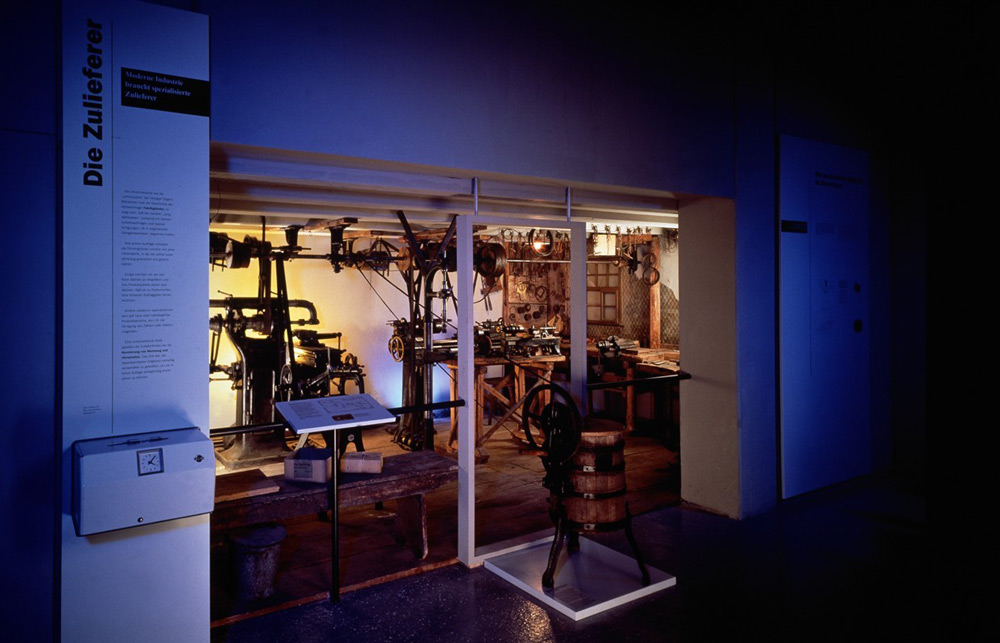Luigi Micheletti Award

In 1989 a selective group of like-minded people formed a project to counteract the creeping death of the clockmaking industry in the Black Forest, and in a town which once called itself the greatest clockmaking town worldwide – Schwenningen. Bankruptcy, unemployment, the demolition of factory buildings and the scrapping of precision engineering production plants has haunted the once thriving region since the 1970’s. For well over 200 years clock manufacturing was the prime determinant of life in the area. The clock factory dominated the lives of the majority of working class families. Human life was determined by the discipline, order and working conditions in the factory. The clockmaking industry influenced the workers’ ways of thinking, skills and social environment. None of this exists today. The whole general set-up has changed. Yet, more than just nostalgic memories linger on.
The machinery and production plants due for scrapping symbolize for many greater part of their own personal history.
The visitor senses a feeling for factory life immediately on entering the museum. Clock-in machines time arrivals and departures from one exhibit room to another. If needed, the staff of production engineers will demonstrate the workings of various machines throughout the exhibition. The visitor is at once spellbound by a world of bygone technology, of the daily lives of factory workers and pressures of production. Transmissions are set in motion, gears are milled and clock hands are stamped. At the same time staff with first hand experience of life in the factories relate stories and anecdotes. Alternatively, the visitor can read about the social history at his own pace on the information plates or leaf through photo albums.
Somewhere in the factory hall the visitor chances upon an elderly man who used to work on the machines. He was a specialist in his field and his whole life has centred around the factory. He worked on the machines, adjusted, rebuilt and adapted them to various production runs. Nowadays, he shares this knowledge with the younger project members who have taken it upon themselves to manufacture a simple alarm clock and, at the same time, try to work out ways to improve its construction.
Tree types of clocks played a dominant role in industrialisation: the night watchman’s registration timer, the invention of which ushered in Schwenningen’s clockmaking industry. The time clock succeeded the registration clock and offered factories world-wide the possibility of controlling and documenting working hours. The third most important type of clock for both workers and the clock factories alike was the alarm clock. An alarm clock produced at good value not only trained workers in discipline, it also made them their own customers.
The museum presents a wide scope of production ranging from these three types of clocks to mechanical clocks and various measuring instruments for traffic, such as the parking meter. The first part of the exhibition was opened in 1994 on the site of the very first clock factory, where 150 years previously the industrialisation of clockmaking in the state of Württemberg began: The Württemberg Clock Factory Bürk.
The museum project grew piece by piece, and in this, reflected the process of clockmaking. After opening its exhibition it took three years before a catalogue could be financed and presented. The second part of construction was planned in two stages: the visitors’ laboratory was opened in 2000 and the exhibits’ hall in 2001.
Whereas the main exhibition with its working place demonstrations aims at a wider stream of visitor, the objective of the visitors’ laboratory is to capture the interest of the younger and more technologically minded layperson and secure the appreciation of the actual working mechanisms of a clock. This hands-on exhibition enables the visitor to grasp and experiment with working parts such as the clock springs, pendulum, balance wheel, escapement and clockwork. To round off the visit to the laboratory you can test our own subjective feeling for a time on a computer.
The impact of the Luigi Micheletti Award
The Luigi Micheletti prize was a great praise for all the unpaid helpers, who worked for the museum for more than 10 years. The initial goal was to create a local museum for the former clock industry and the prize was a stunning success for the small group of people who realized the museum against many reserves.
The prize did help, that the contributions of the town Villingen-Schwenningen and the district Schwarzwald-Baar-Kreis have not been cancelled but only lowered. The museum can not exist without these contributions, as the amount for the tenant and the salaries can not be financed only by private donations.
The museum became more known and it is now easier to cooperate with other museums and to share the temporary exhibitions with other institutions.





